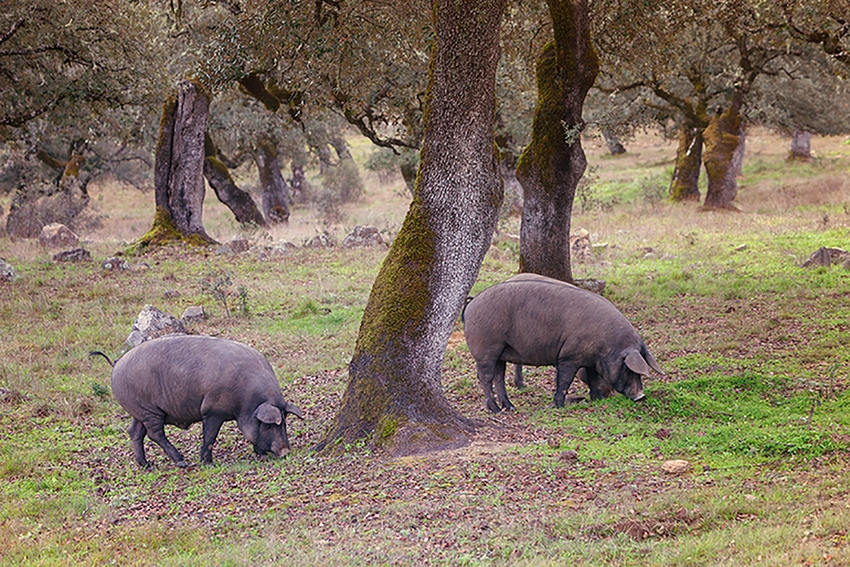African swine fever: How did the Spaniards eradicate it?
Many of the tests we use today for rapid detection both in swine and ticks comes from Spain’s experience.

Teddy Roosevelt once said, “I believe that the more you know about the past, the better you are prepared for the future.”
Those words struck me recently after attending a session on African swine fever at the National Pork Producers Council Fall Alliance Meeting when Neil Dierks, NPPC chief executive officer, mentioned maybe we need to revisit Spain’s history with the virus and how they were able to stamp it out. My ears perked up at the comment, and yes, my mouth began to salivate at the thought of tasting Jamón ibérico again too, but mostly I was just intrigued to know more about their situation. Thankfully Dierks pointed me to a vault of information on ASF and Spain.
Peter Fernandez, a former Animal and Plant Health Inspection Service veterinarian, got his start at the Plum Island Animal Disease Center as a technician in the late-1970s and studied for five years in Spain in the mid-1980s before coming back to the United States and taking his role with APHIS as a foreign service officer overseas. He is an infectious disease epidemiologist and the co-author of the World Organization for Animal Health Atlas of Transboundary Animal Diseases. Fernandez is also an instructor of foreign animal diseases at PIADC and provides lectures on ASF.
And Fernandez says the swine industry could learn a thing or two today from Spain’s experience with ASF.
Spain’s history with ASF
When the disease first entered the southwest European country in the 1960s, control was rather difficult. Veterinary services were still developing in Spain and there were no controls on swine production and movement with a lot of free-ranging swine, similar he says to Russia today. Backyard production and unregulated swill feeding were also common practice.
What makes Spain so notable is the first documented cases of the virus being associated with ticks were recorded there. ASF is the only known arthropod-vectored DNA virus of animals. Some believe it is actually a virus of ticks that happens to affect swine.
“Here’s this virus circulating among Ornithodoros soft ticks and wild African animals and it is never discovered what is really going on until it is uncovered in Spain,” Fernandez says. “Scientists go back to Africa to investigate and sure enough they find the original viral maintenance cycle.”
In the 1980s, Spain becomes a candidate to enter the European Union and begins getting funding from the EU to combat ASF. At this time, Spain develops improved diagnostics for quicker identification of outbreaks, allowing for more effective stamping out and reduction of circulating virus. Fernandez says this creates a more systematic approach and the country develops a five-year plan to combat ASF.
During this time ASF becomes more endemic in Spain and the mortality rate drops to around 5%. While ASF is still a burden, the pork producing sector in Spain continues to grow. In the 1960s production was around 6 million head; by 1989 it had reached 16.7 million, an increase of nearly 180%.
Fernandez says the real serious effort to eradicate the disease though didn’t come until the early 1990s in Spain and Portugal as the EU began to see it as an Iberian issue and started supporting producers with some recompense for swine depopulation.
“As there was no indemnity, producers were reticent to report disease in pigs because they didn’t want them killed and that of course is what was maintaining the virus,” Fernandez says.
With increased funding, Spain was able to implement stricter stamping out efforts, improve veterinary health infrastructure especially at the central and regional levels, make improvements in animal holding facilities, eliminate outbreaks and depopulate infected herds.
Fernandez says no one measure taken by Spanish authorities led to the eradication of ASF but instead a coordinated series of actions, including: official reporting of all detected cases, checking all possible transmission sources, rapid response to detections to ensure expedient elimination of affected animals and vectors and thus the circulating virus, animal identification and movement control from high-risk areas, tracking of disease control through mapping of various levels of progress, control of all levels of pork processing including home slaughter and effective control of swill feeding.
“In areas of Spain where ASF was successfully being eradicated and ticks were eliminated, a complete cleaning and disinfection of premises was undertaken and before restocking, they would identify ASF seronegative swine and introduce them into holding areas at these facilities,” Fernandez says. “These animals would be there for about a month and once Spanish authorities were sure they weren’t becoming infected, repopulation of the farm with clean animals could begin. The process could take about three months.”
No restocking was allowed if premises were found to have ticks. The soft tick vector of ASF feeds opportunistically when swine are more dormant and repose, as these ticks come out of burrows and crevices to quickly take a blood meal before hiding again. The Iberian pig is traditionally raised in oak forests with evening sheltering in stone houses. Trying to find individual ticks would be impossible so the Spanish developed a novel way of detecting tick saliva proteins in pigs. Thus, sentinel pigs were used to ensure elimination of ticks as well as virus.
By 1995, Spain became officially clear of ASF. Portugal declared itself free in 1993, but the virus reemerged in 1999. Fernandez says this final occurrence was likely due to an infected tick that survived eradication as they have been documented to remain infected well over 600 days.
What can we learn from Spain?
You need a good indemnification program.
“I think that’s a big problem for countries the size of Russia. Indemnity is a tricky thing. You’ve got to determine the right price for someone to come forward,” Fernandez says. “There has got to be an incentive and you want to be careful, you don’t want to over indemnify. You must have a good solid indemnity program based on the actual price of pork and swine at the time.”
You need solid collaboration.
“The other thing the Spanish did which is incredibly important, is that they built a solid collaboration between the federal government, regional governments, private industries including the hunting industries and with scientific community, both private for diagnostics and universities for research,” Fernandez says. “You have to create a united front. You can’t have people blaming each other when things go wrong or don’t progress as expected. That always distracts from getting the job done.”
You need solid science.
Fernandez gives the example of when the United States eradicated classical swine fever in the 1970s, and that we had two very important tools at our disposal — a good vaccine and very good diagnostics with excellent laboratory staff to read results.
“With ASF, Spain made a huge contribution in advancing diagnostics,” Fernandez says. “Today many of the tests we use for rapid detection both in swine and ticks comes from Spain’s experience. What we still lack is a viable vaccine for field use.”
You need an economic driver.
Finally, Fernandez says Spain had a driving impulse to join the international marketplace.
“There was an economic driver that allowed these associations, both national pork producers of Spain and their provincial subsidiaries, to convince and get the word out through their members and producers that it was in everyone’s best interest to eradicate and do everything that was asked of them by the national program, whether that be identify animals, to slaughter, whatever it was everyone got on board,” Fernandez says.
What can the U.S. industry take away?
While the U.S. swine industry may want to study soft tick transmission within our borders and more closely monitor its feral pig population, Fernandez says our industry does have its advantages with a solid veterinary infrastructure both at the national and state level, excellent diagnostics and a good relationship between state, federal, industry and allied industries that together create a united front. Maintaining access to important international markets is also an important economic driver.
“I think quite frankly the U.S. pork industry is probably one of the most progressive industries in all aspects of porcine management, especially in the area of animal disease control,” Fernandez says. “They are first in line to make sure all the resources necessary are available to combat high-risk diseases.”
About the Author(s)
You May Also Like





